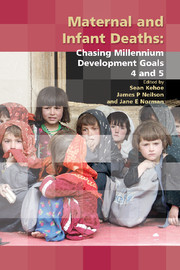Book contents
- Frontmatter
- Contents
- Participants
- Declaration of personal interests
- Preface
- The Millennium Development Goals
- SECTION 1 THE SIZE OF THE PROBLEM
- SECTION 2 CLINICAL PROBLEMS AND SOLUTIONS – MATERNAL
- SECTION 3 CLINICAL PROBLEMS AND SOLUTIONS – NEONATAL
- SECTION 4 TRAINING AND DEVELOPMENT
- 14 Capacity development – a midwifery perspective
- 15 Increasing the capacity for essential obstetric and newborn care
- 16 The role of the Royal Colleges in training and development
- SECTION 5 SPECIFIC CHALLENGES IN SPECIFIC COUNTRIES
- SECTION 6 CONSENSUS VIEWS
- Index
15 - Increasing the capacity for essential obstetric and newborn care
from SECTION 4 - TRAINING AND DEVELOPMENT
Published online by Cambridge University Press: 05 February 2014
- Frontmatter
- Contents
- Participants
- Declaration of personal interests
- Preface
- The Millennium Development Goals
- SECTION 1 THE SIZE OF THE PROBLEM
- SECTION 2 CLINICAL PROBLEMS AND SOLUTIONS – MATERNAL
- SECTION 3 CLINICAL PROBLEMS AND SOLUTIONS – NEONATAL
- SECTION 4 TRAINING AND DEVELOPMENT
- 14 Capacity development – a midwifery perspective
- 15 Increasing the capacity for essential obstetric and newborn care
- 16 The role of the Royal Colleges in training and development
- SECTION 5 SPECIFIC CHALLENGES IN SPECIFIC COUNTRIES
- SECTION 6 CONSENSUS VIEWS
- Index
Summary
Introduction
Each year more than 536000 women worldwide die from complications of pregnancy and childbirth — that is one every minute. Many more survive but will suffer ill health and disability as a result of these complications. Ninety-five percent of all maternal deaths occur in South Asia and sub-Saharan Africa. In addition, an estimated 4 million neonatal deaths occur each year, accounting for almost 40% of all deaths under 5 years. An estimated 3.2 million babies are stillborn and up to 2 million perinatal deaths are intrapartum related. The health of the neonate is closely related to that of the mother and the majority of deaths in the first month of life could also be prevented if interventions were in place to ensure good maternal health.
The provision of skilled birth attendance and the availability of Essential (or Emergency) Obstetric Care (EOC) coupled with newborn care are key strategies that will, if implemented, reduce maternal and neonatal mortality and morbidity. A skilled birth attendant is defined as:
an accredited health professional — such as a midwife, doctor or nurse — who has been educated and trained to proficiency in the skills needed to manage normal (uncomplicated) pregnancies, childbirth and the immediate postnatal period, and in the identification, management and referral of complications in women and newborns.
The term ‘skilled birth attendance’ includes the person (a skilled attendant) and an ‘enabling environment’.
- Type
- Chapter
- Information
- Maternal and Infant DeathsChasing Millennium Development Goals 4 and 5, pp. 229 - 240Publisher: Cambridge University PressPrint publication year: 2010
- 3
- Cited by

